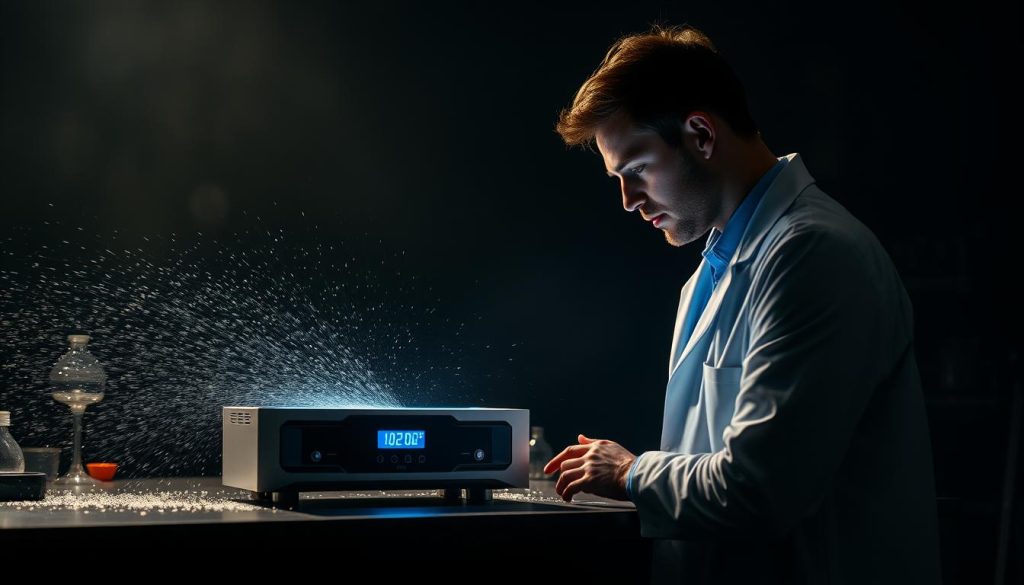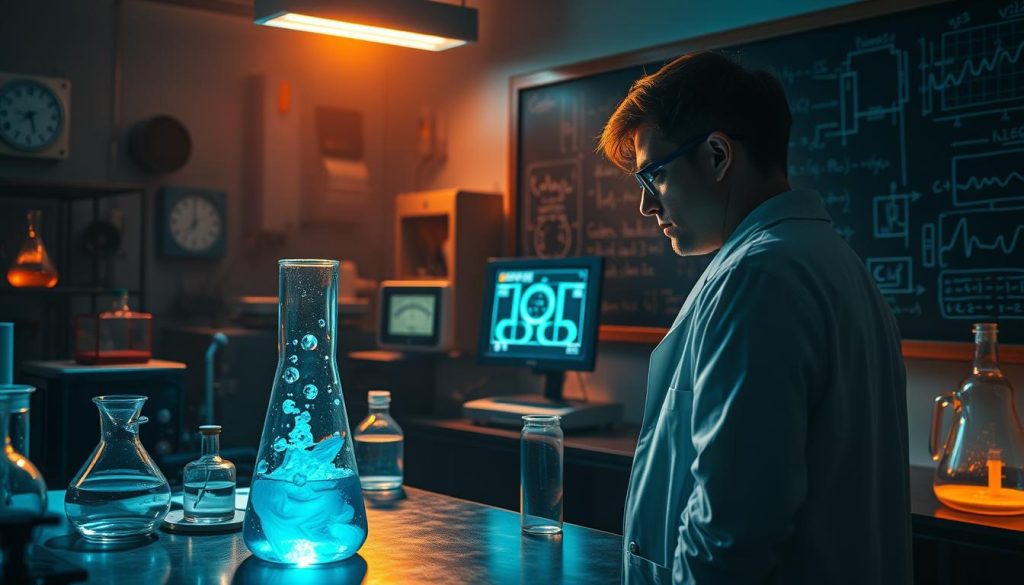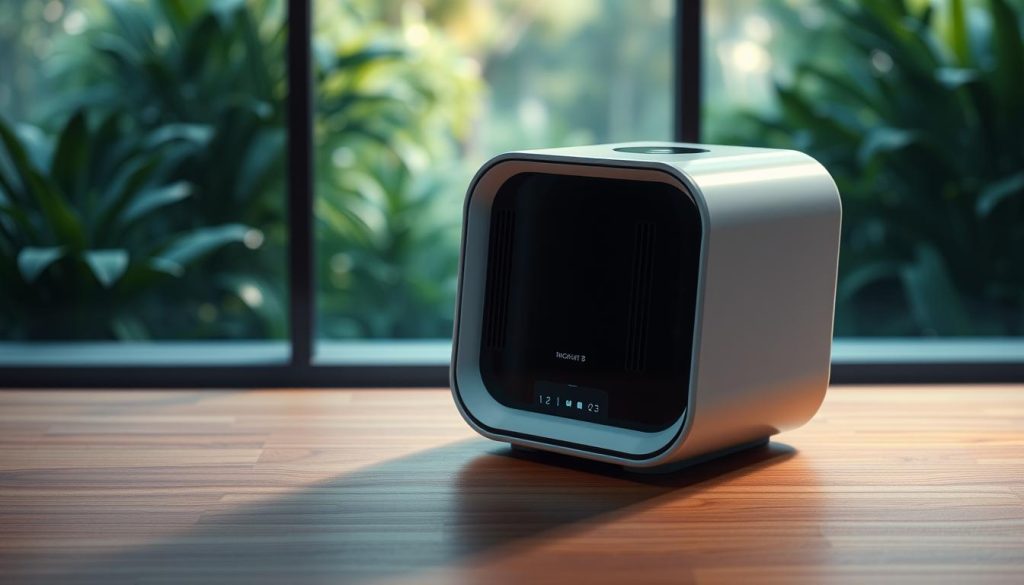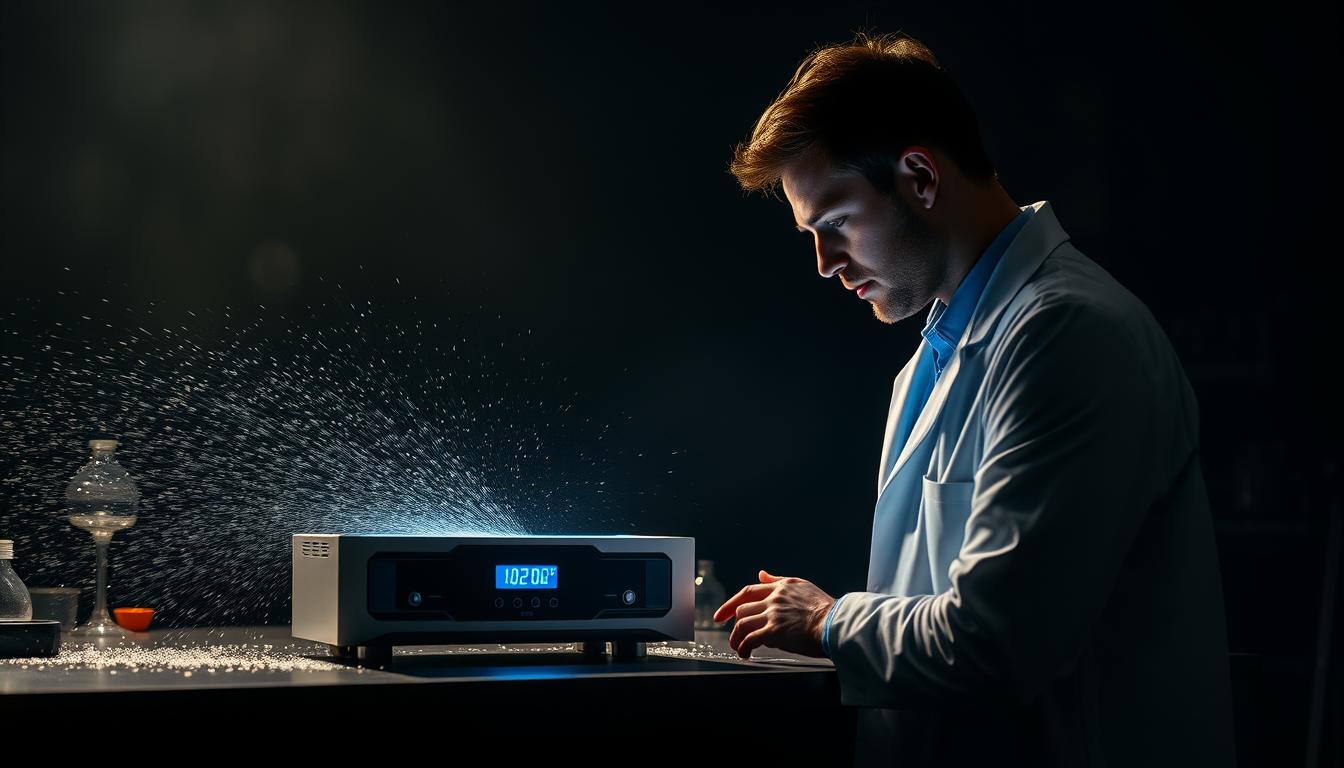The wellness world is buzzing with talk about negative ions and their health perks. But what’s the real deal about negative ions? We’re diving deep into the world of negative ions. We’ll look at their supposed benefits, the science behind them, and the doubts about their effectiveness.
Since the early 1900s, scientists have been studying ionized air. They were curious about its potential to improve air quality and boost well-being. Now, the wellness market is full of products claiming to use negative ion technology. This includes air purifiers and wearable devices. We’ll examine these claims and share our thoughts on whether these tiny particles really deliver.
What are Negative Ions?
Negative ions, also known as anions, are molecules with an extra electron. This process makes them very reactive and good for many places. They help clean the air and improve health by removing harmful particles like dust and pollen.
The Science Behind Negative Ions
Negative ions are made through natural processes. When air molecules meet energy from sunlight or water, they can gain or lose electrons. This creates negative or positive ions. The extra electron in negative ions helps them stick to airborne particles, cleaning the air.
Common Sources of Negative Ions
Many natural negative ion sources exist. Moving water, like from waterfalls, is very effective. Thunderstorms also produce a lot of negative ions. Forests, with their dense greenery, are another source.
Artificial sources, like air ionizers, also exist. These devices release negative ions into the air, making indoor spaces cleaner. Knowing about negative ions helps us see how they improve our health.
How Negative Ions Work
Understanding negative ions is key to seeing their benefits. They interact with air molecules, starting a series of chemical and physical processes. These processes help purify the air. Also, their effect on human health is being studied, focusing on how they interact with cells.
The Interaction with Air Molecules
Negative ions are charged particles found in nature, like near waterfalls and ocean shores. When they meet air molecules, they stick to particles like dust and pollen. This makes the particles heavier, causing them to fall and clean the air.
This process not only cleans the air but also helps in areas with lots of allergens and pollutants.
Effect on Human Cells
Negative ions do more than just clean the air. They are thought to boost biochemical reactions in human cells. This leads to more serotonin, a chemical that makes us feel happy.
Studies also show that negative ions can improve oxygen flow and cell function. This can make us feel more alive. The benefits include better mood and breathing, making negative ions an interesting area of study.
Do Negative Ions Really Work?
Many people wonder if negative ions really work. There’s a mix of scientific facts and personal stories. Let’s explore the health claims and their supposed benefits.
One big claim is that negative ions clean the air. Studies say they can get rid of dust, dander, and germs. Users often say the air feels fresher and clearer after using these devices. But, some doubt if everyone will notice the same change.
Some research also links negative ions to better mood and less stress. But, not all studies agree. This debate shows the mixed feelings about their mental health benefits.

| Application Area | Positive Outcomes | Negative Outcomes |
|---|---|---|
| Air Quality | Reduced pollutants | Subjective changes |
| Mental Health | Improved mood | Mixed study results |
| Overall Well-being | Increased energy | Lack of consistency |
Some say we need more solid research to prove the health benefits of negative ions. For now, their effects on air and mental health seem to vary a lot. This depends on who you are and the situation.
Exploring the Benefits of Negative Ions
Negative ions are known for their health benefits, making them a hot topic in wellness. They help improve air quality and boost mood and mental clarity.
Improved Air Quality
Many people say negative ions clean the air by removing pollutants and allergens. Studies show they can bind to dust, pollen, and smoke, making the air cleaner. This is great for those with breathing problems or allergies, offering a natural way to breathe better indoors.
Enhanced Mood and Mental Clarity
Negative ions are also linked to better mental health. They may increase serotonin levels, improving mood and mental focus. The term mood elevation ions shows their power to uplift emotions, reducing stress and anxiety.
Being around negative ions, like near waterfalls or during thunderstorms, can make you happier and more alert. This supports the idea that negative ions have a positive impact on our mental state.
Negative Ion Technology in Modern Products
The demand for wellness and air purification has grown, leading to a boom in the ionized products market. Ion-generating gadgets, from air purifiers to bracelets, are now common. These devices use negative ionizers to clean and refresh the air we breathe.
But it’s not just air purifiers that use negative ion technology. You can find it in bracelets that claim to boost energy and reduce stress. Even mattresses are now infused with negative ions to help you sleep better. The technology is used in many ways, often by adding materials that release beneficial ions.
The variety of products in the ionized products market is vast. Yet, not all claims are supported by evidence. Studies on negative ionizers have shown mixed results. Some products really work, while others don’t. It’s crucial to carefully evaluate these claims and understand how each product uses negative ion technology.
Negative Ion Research: What Do Studies Say?
Research into negative ion therapy has uncovered interesting facts. Many studies have looked into how negative ions can help our health and performance. They’ve found links to better health and improved performance.
Studies have shown that negative ions can help our breathing and clear our minds. These early results suggest that negative ions might have real benefits. They encourage us to keep studying to learn more.
Research also shows that negative ions can make us feel happier. People who were exposed to more negative ions felt less stressed and anxious. This could mean good news for our mental health.

Studies have also looked at how negative ions affect our environment. They found that negative ions can make the air cleaner. This cleaner air might help us breathe better, supporting what people have said in clinical settings.
| Study | Focus Area | Outcome |
|---|---|---|
| University A (2021) | Mental Health | Reduced anxiety and depression |
| Institute B (2020) | Respiratory Function | Improved lung capacity and breathing |
| Research Center C (2019) | Air Quality | Enhanced air purity in urban areas |
The research on negative ion therapy is growing. As more studies come out, we’ll learn more about their effects. The scientific world is eager to understand how negative ions work in different areas.
Negative Ion Science: Myth or Miracle?
More people are curious about negative ions and their health benefits. But, scientists are still unsure if these ions really help. The debate is fueled by stories of their benefits versus solid scientific proof.
Many studies have tried to prove the science behind negative ions. But, some say the good effects might just be in our heads. This doubt comes from tests that don’t show the big promises made by some products.
Still, some studies suggest negative ions can make the air cleaner and improve our mood. They look at how these ions mix with air particles, possibly making it healthier. Yet, many experts say we need better research to be sure.
Some studies show a clear split:
| Aspect | Positive Findings | Critical Findings |
|---|---|---|
| Air Quality | Improvement in particulate removal | Inconclusive results in controlled settings |
| Mood Enhancement | Reports of increased energy and mood | Placebo effect argued by critics |
In summary, while some studies back the idea of negative ions, many doubts remain. The big claims often face tough scientific checks. The ongoing debate shows we need more thorough research to fully understand the science behind negative ions.
The Role of Negative Ion Therapy in Health and Wellness
Negative ion therapy is becoming more popular in health and wellness. It offers many benefits. This section explores its uses and advantages.
Applications in Medical Treatments
Negative ions are used in many medical ways. They help with breathing problems and improve mood and thinking. Hospitals use them to clean the air and fight infections.
Studies suggest negative ions help with depression, anxiety, and SAD. They boost serotonin, which makes us feel better.
Therapeutic Benefits Claimed
People say negative ions are good for the heart, immune system, and sleep. They fight the bad effects of pollution. This helps us stay healthy.
| Condition | Negative Ion Benefits | Scientific Evidence |
|---|---|---|
| Respiratory Issues | Improved air quality, reduced allergens | Studies indicate a reduction in symptoms |
| Mental Health | Reduction in depression, anxiety | Clinical trials confirm mood enhancement |
| Sleep Disorders | Better sleep quality and duration | Ongoing research shows positive results |
In summary, negative ions are still being studied but show great promise. They are used in medicine and daily life. They could help with many health issues.
Best Negative Ion Products on the Market
Choosing quality negative ion generators can be tough. There are many top-rated ion products out there. These include air purifiers, wearables, and gadgets that improve your health and environment. We’ve made a list to guide you, focusing on product effectiveness, user satisfaction, and value.

| Product | Type | Effectiveness | User Satisfaction | Value for Money |
|---|---|---|---|---|
| IQAir HealthPro Plus | Air Purifier | High | 95% | Excellent |
| Wearable Ionizer Necklace | Wearable | Moderate | 85% | Good |
| AirTamer A310 | Wearable | High | 90% | Very Good |
| Pure Enrichment PureZone | Air Purifier | Moderate | 88% | Good |
| ION Pacific ionbox | Compact Ion Generator | High | 92% | Excellent |
These top-rated ion products were chosen from many reviews and feedback. The IQAir HealthPro Plus and ION Pacific ionbox are top picks for their effectiveness and user satisfaction. They’re great for those who care about air quality.
Wearables like the AirTamer A310 are perfect for those always on the move. Whether you need something portable or powerful, these products meet your needs.
How to Choose Effective Negative Ion Products
Finding the right negative ion product can be tough with so many choices. By looking at critical factors ion products and what others say, you can choose wisely. This buying guide for ion products will help you every step of the way.
Factors to Consider
When picking negative ion products, look at a few key things to make sure it’s worth it. Here are important points to think about:
- Ion Output: Check the ion output levels. Higher outputs mean better air cleaning and health benefits.
- Product Certification: Look for certifications from trusted groups. They show the product’s quality and how well it works.
- Brand Reputation: Choose brands like Sharp, AirTamer, or CleanWave for reliability and good performance.
- Price vs. Features: Compare the product’s features and price. A higher price doesn’t always mean better quality.
- Portability: If you’re always on the go, a portable or wearable device might be best.
Consumer Reviews and Recommendations
Looking at consumer ion opinions can give you great insights. Many people share their experiences online, talking about what they like and dislike. Experts say to read these reviews carefully to learn about common problems and special features.
| Product | Consumer Rating | Key Features |
|---|---|---|
| Sharp Plasmacluster | 4.8 / 5 | High ion output, certified for air purification |
| AirTamer A310 | 4.5 / 5 | Wearable, highly portable |
| CleanWave Portable Wand | 4.3 / 5 | Durable, multi-surface sanitizing |
Negative Ion Reviews and Testimonials
The power of negative ions is best understood through user experiences. Many people have shared their thoughts on negative ions. They talk about their effectiveness and benefits.
One common theme is the improvement in air quality. Users say the air feels fresher and cleaner after using negative ion generators. This is true for many products, like air purifiers and wearable ionizers.
Users also talk about feeling better mentally. They say they concentrate better and feel more uplifted. These feelings are hard to measure but show the benefits of negative ions.
Not all reviews are positive, though. Some people say they didn’t notice any change. These mixed reviews show that everyone reacts differently to negative ion technology.
Some users have reported side effects like headaches or dizziness. But these cases are rare. Most people have positive experiences.
In conclusion, reviews of negative ions show a range of experiences. While many people see big benefits, others don’t notice much. These personal stories add to the conversation about negative ions, mixing personal experiences with scientific research.
Potential Side Effects and Risks of Negative Ions
Many people believe negative ions are beneficial. But, it’s important to know the risks. In safe settings, they can be helpful. Yet, too much or misuse can cause problems.
One big worry is breathing issues. This is true for those with asthma or other lung problems. Too many negative ions can make symptoms worse. So, it’s key to watch the air and ion levels closely.
Some users have felt headaches, dizziness, or nausea from too many negative ions. It’s thought that too much can upset the body’s natural balance. Always follow the instructions for ionizers and watch for any health changes.
To stay safe, follow some important steps. Make sure devices meet safety standards and use them in rooms with good air flow. This helps avoid too many ions. Also, talk to a doctor before trying negative ion treatments, if you have health issues. Being careful can help enjoy the good effects of negative ions without the bad.

